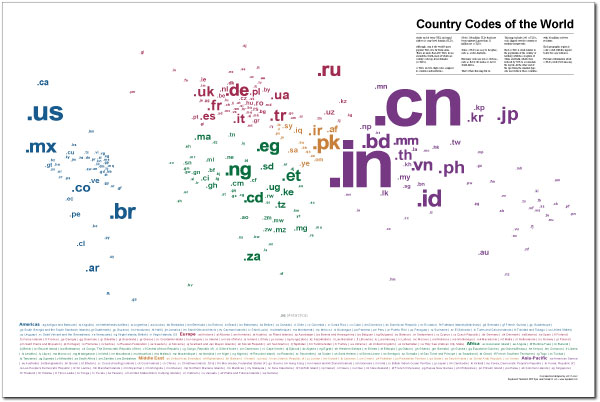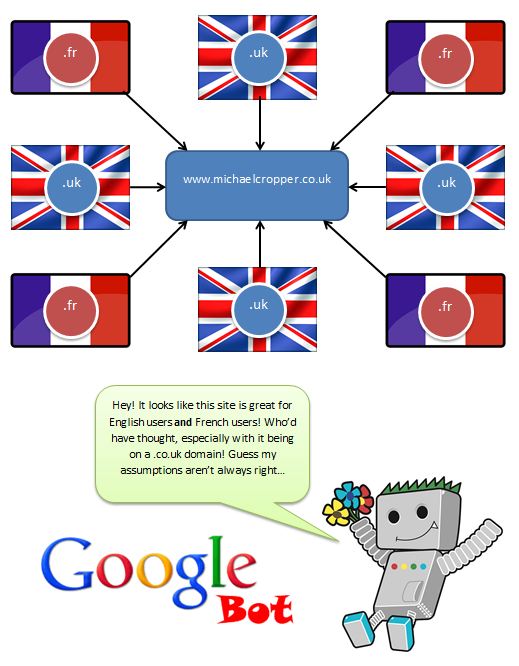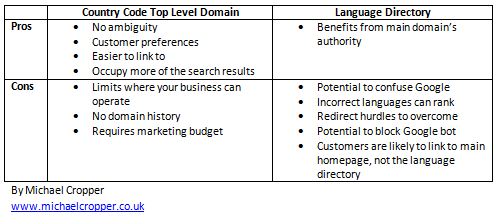There is a lot of different discussions around the web about whether you should use a Country Code Top Level Domain (ccTLD) or a Directory when scaling a website up into multiple languages or countries, so I am going to give an overview of the pros and cons for each method.
The main question many people ask is that when moving into a new market is which should be used to get the maximum benefit? A country code top level domain or a directory?
Country Code Top Level Domain (ccTLD)
A country code top level domain is a domain that is bound to a specific country, such as .uk for United Kingdom, .au for Australia, .cx for Christmas Islands, .fr for France, .th for Thailand etc.
Pros of Country Code Top Level Domains
- Clear signal to Google who the website is targeting. There is no ambiguity, when Google looks at your website www.example.com.au it is clear that the website is targeting Australian users. Usually in Google Webmaster Tools you can set which country you want your website to target, when your website is on a generic top level domain such as .com. Although when your website is on a ccTLD this information is not available since Google assumes (correctly or not) that you are targeting customers within that country.
- Another benefit to having a ccTLD is that some users in certain countriesprefer to buy from those domains. For example people in Australia are extremely patriotic and prefer to buy from .com.au domains (company in Australia domain). Where as in somewhere like Thailand, people prefer to buy from a .com domain opposed to a .co.th (company in Thailand) domain since there can be a lot of poor quality websites on .co.th domains. So Thai people believe .com businesses will provide a better service or product. This isn’t always the case and there will always be people with different preferences, so when moving into a new market it is essential to do your own research into what would work best for your business.
- It is a lot easier for a user to link to www.website.co.th than it is for a user to link to www.website.com/th/. By making this process simpler then it could lead to an increase in natural links for your website.
- By having several country code top level domains it is possible to occupy more of the search results pages for branded search queries. For example if someone searched for “your brand” then it is possible that your .co.uk website, .com website and .co.th websites could all rank. Google is no where near perfect when it comes to language differentiation although it is getting better.
Cons of Country Code Top Level Domains
- The obvious one here is that it kind of limits where you can operateyour business. If you are on a .co.uk domain, then it is unlikely that you are going to rank well in other markets due to how Google perceives ccTLDs as shown above. That said, if you have plenty of local links say from .fr domains, then Google isn’t going to totally ignore them. It is likely going to ignore the ccTLD and change its mind and say ‘even though the domain is a .co.uk domain, this website has lots of links from .fr domains, so it must be relevant for French users too’ as shown in the image below. I have seen a lot of random and non relevant websites on other ccTLDs rank in strange places in the past, but I would put that down to Google’s poor algorithm.
- One potential pitfall of using a country code top level domain is that all of the links from your main aren’t fully being utilised and there is no history to your new domain. That said, what most larger websites tend to do is link all of their ccTLD domains together so that each page in a different language links to all of the other languages, so www.website.com/en/pageone.html would also link through to www.website.com/fr/pageone.html, or www.website.co.th/pageone.html and www.website.com.au/pageone.html would like together and vice versa.
- To successfully launch a new language / localised website then it is important to consider what marketing budget is available to really push the new website. It does require significant effort to launch a new website into another market so think carefully about the options. If the website is simply being translated in the hope that some traffic will magically appear then a ccTLD is probably not the best option, instead just use the main domain with the new languages in a directory.
Language Directories
The second option when scaling a site up into multiple languages is to use a directory for each language such as www.website.com/fr/ for France (or French) and www.website.com/th/ for Thailand (or Thai). One important point to think about here is if you are targeting a certain country or a certain language, or both?
Taking French as an example, if you are only targeting France as a country then you will be missing out on a massive market from other French speaking countries and this can be quite big. There are 28 countries around the world where French is a national language which include: Belgium, Benin, Burkina-Faso, Burundi, Cameroon, Canada, Central African Republic, Chad, Comoros, Democratic Republic of Congo, Djibouti, France, Gabon, Guinea, Haiti, Ivory Coast, Luxembourg, Madagascar, Mali, Monaco, Niger, Republic of Congo, Rwanda, Senegal, Seychelles, Switzerland, Togo and Vanuatu.
Another option here is to target both language and country by providing a full localised directory such as www.website.com/ca-fr/ for Canadian people who speak French and www.website.com/be-fr/ for Belgium people who speak French.
Pros of Language Directories
- One of the main pros to having all new languages in a directory is that all of the inbound links to your website will flow through to the new language pages. That said, this would also happen when linking your different ccTLDs together correctly although is it not fully known if both of these methods would pass the same amount of Google Juice through.
Cons of Language Directories
- One of the potential pitfalls of having languages in a directory opposed to on a ccTLD is that Google could confuse the site as being a total mess in multiple languages. Although this isn’t likely to happen and you can set each directory to be targeting a specific country within Google Webmaster Tools as shown above.
- It is possible that for branded search queries that you will find your main pages ranking in the incorrect language which isn’t a great user experience. For example if someone is searching for “your brand” from France then it is very likely that the main English website will rank since the English page has far more Google Juice strength and it can be difficult to get this correct.
- The issue of what content you should display on the ROOT of the domain, www.website.com? Should it be English or one of the other languages? Then this takes you into the realm of potentially redirecting users either based on the IP address or on their language settings from the browser. Bearing in mind that the incorrect language could also show as a snippet in the search results which would dramatically reduce the click through rate.
- If you are thinking of automatic redirects for users then you may havepotential Google Bot issues with cloaking. There is no clear info from Google as to what is best here and they have even totally contradicted their self several times on this issue. There is also the possibility that if the automatic redirects haven’t been set up correctly that you could accidentally block Google from accessing most of your website. For example since Google Bot always crawls from America then you wouldn’t want to be redirecting Google Bot to the English page all of the time since it would never discover any of the other content!
- People within the market you are entering are likely to link to the main website and not the localised directory, for example you will find a lot of people would link to www.website.com opposed to www.website.com/th-th/ which could hinder how well the language directories rank within the local search engines.
Summary
There is no quick win to breaking into a new market and there are a lot of pros and cons to each of the different methods, country code top level domains and directories. Personally I would prefer to use ccTLDs where possible if there is going to be a real push into that market.
If you are just thinking about translating and not promoting then it is a waste of money, similar to buying a phone and expecting it to ring on its own! Nothing worth while is easy, so it is going to take considerable effort to break into the market.
You may have noticed that I have not mentioned the option for sub-domains within this post and that is because I don’t like sub-domains  But if you are interested then I am sure you can pull some of the above points for/against sub-domains too.
But if you are interested then I am sure you can pull some of the above points for/against sub-domains too.
Hopefully this has provided you a wide range of information on the topic and will help you decide what is best for your website.
Here is a summary table outlining all of the different points listed above
Michael Cropper
Latest posts by Michael Cropper (see all)
- WGET for Windows - April 10, 2025
- How to Setup Your Local Development Environment for Java Using Apache NetBeans and Apache Tomcat - December 1, 2023
- MySQL Recursive Queries – MySQL While Loops – Fill Zero Sum Dates Between Dates - October 6, 2023



